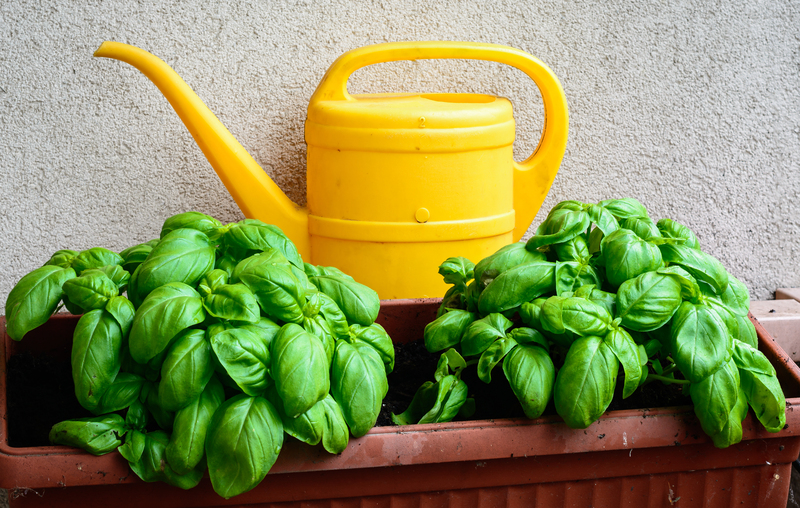Fortifying Your Garden Against Stormy Weather
Posted on 20/05/2025
Fortifying Your Garden Against Stormy Weather: Essential Strategies for Resilient Landscapes
Stormy weather can wreak havoc on even the best-tended gardens. From lashing winds that upend delicate plants to torrential rain that turns soil into rivers of mud, thunderstorms, hurricanes, and other severe weather events pose serious threats to your green haven. Luckily, with the right preparation, you can strengthen your garden's defenses and minimize storm-related damage. This comprehensive guide will help you discover numerous practical strategies for protecting and fortifying your garden against unpredictable and destructive weather conditions.
Understanding the Impact of Stormy Weather on Gardens
Severe weather events can lead to a range of problems in the garden, including:
- Wind damage: Broken stems, torn leaves, and even uprooted trees.
- Flooding and waterlogging: Saturated soil causing root rot and plant death.
- Hail impacts: Bruises, shredded foliage, and snapped branches.
- Soil erosion: Loss of topsoil and key nutrients.
- Temperature fluctuations: Cold snaps, heat spikes, and increased plant stress.
Being aware of these risks is the first step towards garden storm protection. Now, let's delve into actionable steps you can take to fortify your garden against the next onslaught of rough weather.

Assessing Your Garden's Vulnerabilities
Before you can effectively stormproof your garden, it's essential to identify problem areas:
- Watch for water accumulation after heavy rain; low-lying spots are prone to flooding.
- Note wind patterns and observe which areas receive the brunt of strong gusts.
- Identify exposed beds and unsupported taller plants that might topple easily.
Take a thorough walk through your garden after a storm. Monitor plants and structures for damage. This will give you clues on what needs reinforcing or replanting and inform your preventative strategy going forward.
Storm-Resistant Design: Planning Your Garden with Weather in Mind
Integrating weather resilience in your garden design is key. Consider these elements:
Choosing the Right Plants
- Native plants usually have stronger wind, rain, and drought resistance.
- Deep-rooted species are less likely to be uprooted by intense storms.
- Flexible, pliant plants can bend rather than break in strong winds.
Research which plants thrive in your local climate and soil type--they'll naturally be more storm-resistant!
Smart Garden Layout
- Stagger plant heights: Place taller shrubs and trees at the back or as windbreaks with shorter, more vulnerable species nested closer to the ground and behind natural barriers.
- Group plantings: Block planting (clustering the same plant types together) offers mutual protection during storms and helps shield sensitive species.
- Consider raised beds for drainage: Elevate delicate plants to protect their roots from waterlogged soil.
Building Windbreaks and Barriers
Strategically placed windbreaks are one of the most effective ways to protect your garden from stormy weather. Windbreaks can reduce wind speed by up to 50%, greatly minimizing plant and soil damage.
- Hedges made of hardy, dense shrubs such as boxwood or privet work well.
- Fences and trellises can deflect wind, especially when constructed of slatted materials that filter rather than block airflow entirely.
- Living windbreaks, such as rows of evergreens, also serve as long-lasting, attractive barriers.
Soil Management: The Foundation of a Storm-Proof Garden
Enhancing Drainage and Preventing Waterlogging
Storms often bring excessive rainfall. If your soil cannot handle it, roots can drown. Improve your garden soil's resilience:
- Amend heavy soils with compost and organic matter for better water absorption and aeration.
- Install French drains, gravel, or soakaway pits in low-lying areas.
- Construct raised beds to improve runoff and protect root systems.
- Use mulch extensively to regulate soil temperature and reduce surface runoff and erosion.
Combatting Soil Erosion
Soil erosion can strip your beds of nutrients and make plant survival impossible. Prevent it by:
- Planting groundcover species like creeping thyme, clover, or ivy on exposed soil.
- Terracing sloped gardens to slow water movement.
- Using retaining walls or logs to reinforce banks and borders.
Securing Trees, Shrubs, and Delicate Plants
Staking and Tying Supports
Upright, young, or top-heavy trees and shrubs require extra support ahead of severe weather:
- Stake new trees with sturdy wooden or metal supports angled into the prevailing wind direction.
- Tie growing stems with soft ties or garden twine--avoid damaging the bark.
- Prune dead or weak branches before storms to reduce breakage and wind resistance.
Check all ties and stakes periodically--loose ones won't help, and tight ones can cut into stems.
Using Protective Covers
Temporary covers can save crops and blooms from hail and heavy rain:
- Floating row covers made from breathable fabric shield tender plants.
- Cloche domes and plastic tunnels protect vegetable beds.
- Shade cloths can shield from both high winds and sun after a storm has passed.
Caring for Edible Gardens Through the Storm Season
Vegetables and Herbs
- Avoid planting in depressions that fill with water quickly.
- Choose smaller-fruited or bush varieties which are less prone to breakage.
- Use cages, hoops, and supports for tomatoes, peppers, beans, and peas.
Fruit Trees and Vines
- Thin fruit clusters in advance--this reduces limb breakage and wind resistance.
- Install trellis or strong wires for grapevines and berry canes.
- Mulch generously to prevent soil erosion.
Protecting Garden Structures and Gardeners
Safe Storage and Structural Inspection
- Secure sheds, greenhouses, and fences. Inspect for weak boards, loose screws, and poor anchoring.
- Store garden tools, furniture, and ornaments inside or securely fastened to prevent them from becoming airborne hazards.
- Reinforce greenhouse glass or install polycarbonate panels less prone to shattering.
Safety for Gardeners
Never garden during an active storm. Stay sheltered indoors until conditions are safe before inspecting any damage or starting repairs.
Best Practices for Post-Storm Garden Recovery
Assessment and Clean-Up
- Survey your garden for damage as soon as it's safe.
- Remove broken branches, uprooted plants, and debris promptly.
- Check supports and ties and replace any that have failed.
Saving Damaged Plants
- Prune clean breaks to prevent disease.
- Replant lightly uprooted plants, firming soil around roots and watering thoroughly.
- Avoid heavy fertilization immediately after a storm; give your plants time to recover.

Embracing Long-Term Garden Fortification
- Practice regular maintenance: Prune, mulch, amend soil, and check supports each year.
- Install permanent windbreaks and rain gardens to redirect and absorb stormwater.
- Choose new plants for storm resistance as you expand your garden.
- Stay informed about local weather forecasts and make preparations before storms arrive.
Conclusion: Reap the Rewards of a Resilient Garden
Storm-resilient gardens are not only practical; they are beautiful and sustainable. With the proactive tips provided--from soil management and smart planting to installing windbreaks and storm-proofing garden structures--you'll fortify your garden against stormy weather and enjoy a lush outdoor space throughout the seasons.
Share your own tips for storm-proof gardening in the comments, and let's help each other weather the wildest storms together!
- Related Searches: Protecting garden from storm, Garden wind resistance, Weatherproofing outdoor plants, Flood-proof garden beds, Garden windbreak installation, Garden recovery after storm.

